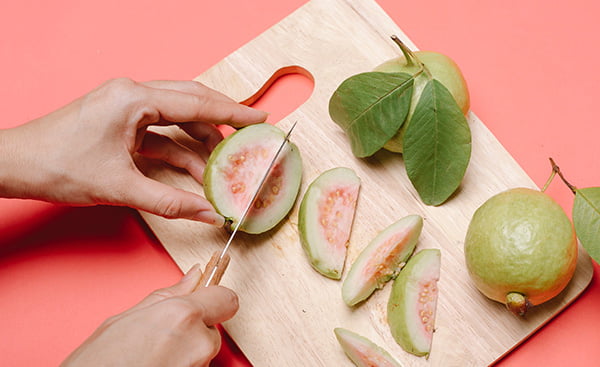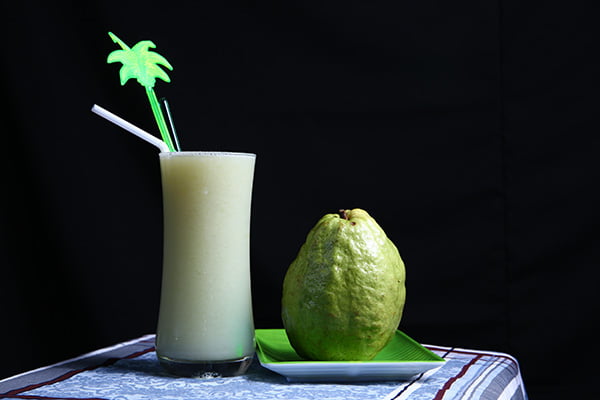Guavas are tropical fruits with a sweet flavor and slightly tart with a uniquely delicious taste. This vibrant, delicious fruit is a flavor bomb packed with nutrition and native to the lush regions of Mexico, the Caribbean, Central America, and northern South America. Its juicy sweetness and subtle tartness make it a versatile delicacy that can be enjoyed straight off the peel, sipped as juice, or blended into refreshing smoothies.
Whether you're a seasoned guava lover or just discovering its delights, this nutrient-dense fruit offers benefits that are simply irresistible. Check out our guava guide below for how to eat guava and enjoy its full health benefits.
Which Parts Of The Guava Can You Eat
The entire fresh guava fruit is edible- from the flesh to the seed and grind. While some may opt to discard the skin and seeds, you'll miss out on this tasty treat's full potential.
The guava seeds are a chewy delight to enjoy as a crunchy ice cream topping or a fresh addition to salads. However, some may find them a bit too hard for their liking. The seeds are packed with fiber and can be consumed along with the flesh, but straining them out is an easy fix for those who prefer a smoother texture, especially when making juices, jams, or purees.
The star of the guava is undoubtedly its flesh. Bursting with sweetness and a hint of tartness, the flesh ranges in color from a pale white to a deep pink or even a rich red, depending on the variety. It's soft, succulent, and packed with nutrients, making it a favorite for fresh eating. A 100-gram raw guava can contain 275% of the daily value of vitamin C and is packed with dietary fiber. The flesh is where you'll find guava's signature flavor, perfect for blending into smoothies, slicing into salads, or simply enjoying on its own for a refreshing treat.
Sporting a green-to-yellow hue, the rind hints at the fruit's ripeness. Though often overlooked, the rind is entirely edible and has a slightly more tart flavor than the flesh. For those who enjoy a full-spectrum flavor experience, the rind can be a delightful addition to your guava consumption, adding texture and depth to the fruit's taste profile. However, some may find its flavor too intense or the texture too firm, opting instead to peel the fruit before indulging.

How To Eat Guava: Step By Step
Select a soft guava that emits a delightful, sweet fragrance when touched. Ripe guavas have a greenish-yellow or bright yellow skin color, depending on the variety.
Place the guavas under cold running water. Use your hands to gently rub the surface of the fruit to remove any dirt or residues.
Pat the guavas dry with a clean towel, or let them air dry. This step is important to prevent slipping when cutting.
Peeling is optional since the skin of the guava is edible and contains nutrients. However, you can do so if you prefer to peel the guava or if the skin is too tough. Gently peel the skin off with a vegetable peeler or a small paring knife. Start from the top and work your way down, following the curvature of the fruit.
Place the guava on a cutting board. Cut the guava in half from the top to the bottom using a sharp knife. This will expose the seeds and the flesh. If you opt to remove the seed, use a spoon to scoop out the seeds from the center of each half.
You can now cut the guava into slices or wedges, depending on how you plan to eat it. If you've peeled the guava, slicing it into thin wedges is popular. If the skin is left on, you might prefer to cut it into thicker slices to make it easier to eat around the skin.

Ways To Eat Guava
Enjoy As Is
Ripe guava is perfect to enjoy as they are, and the entire fruit is edible. But be careful when eating guavas as they have edible seeds in the middle, which can be hard to chew. Cut the fruit in half to prepare the guava, scoop out the guava seeds, and enjoy the juicy flesh. Guava is great for snacking or a sweet and healthy treat on the go.
Juiced
Guava is a popular ingredient in juices, smoothies, and cocktails, as it will add a burst of tropical flavor. Blend the fruit with water, ice, and other fruits for a delicious and refreshing smoothie.
Guava juice is a refreshing beverage, and it is a popular tropical drink known for its sweet, tangy flavor and nutritional benefits. Guava juice can be enjoyed independently or used as an ingredient in cocktails, mocktails, and other fruity beverages.
Baked Into Dessert
Guava is a versatile fruit that can be used in various recipes. Try baking guava into cakes, pies, or pastries if you prefer a sweeter treat. The unique flavor of guava is a perfect complement to traditional dessert recipes, and it adds a touch of tropical flair to your baked goods.
Grill It
Grilling guava is a delightful way to enjoy this tropical fruit, highlighting its natural sweetness and adding a smoky depth that enhances its flavor profile. When grilled, the sugars in the guava caramelize, creating a slightly crisp exterior and a tender, warm interior. This simple and versatile preparation method allows the fruit to be served as a dessert, a side dish, or even incorporated into savory recipes.
Preserved
Guava is often used to make puree, jams, jellies, and syrups, which can be used to add a touch of tropical flavor to your favorite dishes. The good news is you can use any type of guava, such as lemon guava, apple guava, or strawberry guava, to make preserves. You can use these preserved guava like guava jam or puree as topping to your ice cream, yogurt, avocado toast, pizza, and more.
Use As Toppings
You can add ripe guava as a topping to your salad, coleslaw, yogurt, or smoothie bowl.
Guava Paste
Guava paste can be enjoyed in various ways. It is commonly used as a filling for pastries, such as empanadas or turnovers, where its sweet flavor pairs well with flaky pastry dough. It is also popular in desserts like cakes, cookies, and tarts. In addition to its use in sweet treats, guava paste can be enjoyed simply sliced and served with cheese or crackers, creating a delicious combination of sweet and savory flavors.
Fresh Guava Salad
The mild sweetness and light floral notes of white guava make it perfect for a fresh fruit salad. Combine sliced white guava with other tropical fruits like mango, pineapple, and papaya. Dress with a squeeze of lime juice and a drizzle of honey to enhance the natural flavors of the fruits. This salad is refreshing, hydrating, and packed with vitamins, making it an ideal summer treat.
Smoothie
You can use any type of ripe guava to make a smoothie. My favorite is the pink guava. The vibrant pink flesh of this guava variety is a feast for the eyes and the palate, with its sweet and tangy flavor profile and sweet scent.
Blend pink guava flesh with bananas, a splash of coconut milk, and a handful of ice to create a thick smoothie bowl. For a nutritious breakfast or snack, top it with granola, sliced almonds, coconut flakes, and fresh berries. The bold flavors and rich color of pink guava make this smoothie bowl irresistibly delicious.
BBQ Sauce
Red guava's deep flavor and slight acidity work wonderfully in savory applications, such as a homemade BBQ sauce. Puree red guava flesh and mix it with tomato sauce, vinegar, brown sugar, garlic, and spices to create a unique BBQ sauce that adds a tropical twist to grilled meats or tofu. The sauce marries the sweetness of guava with smoky and spicy notes, elevating your BBQ dishes to new heights.
Infused Water
For those seeking to flavor their water, try it with fresh tropical guava. The sweet and tangy flavor of yellow guava is a perfect variety. Its citrusy undertones make it an excellent choice for infusing water. Slice yellow guava and add it to a pitcher of cold water along with slices of lemon and a few mint leaves. Let it infuse for a few hours or overnight. The result is a refreshing and subtly flavored water that's perfect for staying hydrated on hot days or serving at a brunch.
